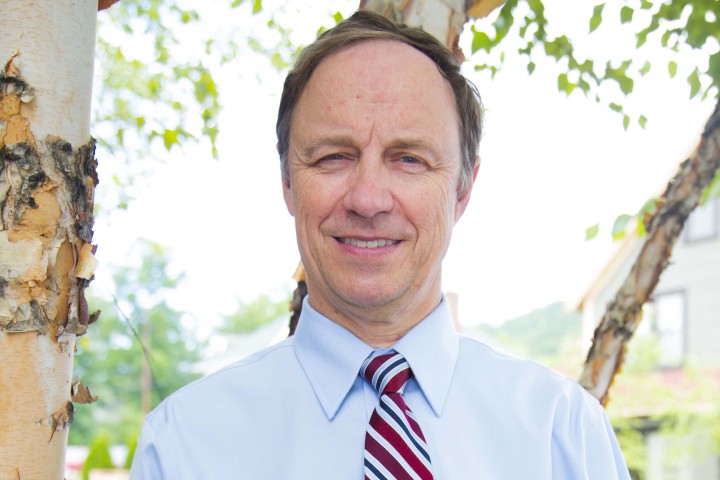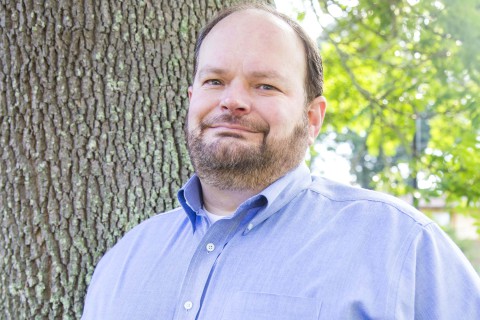Every nonprofit director has a horror story about the perils of relying on outside funding.
“It’s a house of cards,” says Jim Barrett, executive director of Pisgah Legal Services.
“Stressful,” says John Lauterbach, executive director of Caring for Children. “It’s competitive every year.”
“I’ve done WIC for 28 years now,” adds Georganna Cogburn, nutrition program manager at Buncombe County Health & Human Services. “And for many years, like this past year, we wondered, ‘Are we going to get funded?’ when the legislators aren’t wanting to pass the budget.”
A dizzying number of nonprofits call Western North Carolina home, and many are involved, to varying degrees, in helping local children. Pisgah Legal Services, for example, typically provides legal assistance to over 100,000 people a year in six WNC counties on everything from domestic violence to preventing homelessness; last year its programs served 5,598 kids. Caring for Children helps families in crisis. Community Action Opportunities coordinates the local Head Start program, which helps pre-kindergartners develop academic skills and school readiness. WIC, a federal government program (fully titled Women, Infants and Children Supplemental Nutrition Program), gives qualifying citizens prenatal and postnatal care.
But while these groups vary widely in size and in the services they offer, they all rely on outside support. And that, notes Barrett, is a precarious business, especially amid the continuing decline of both federal and state funding.
For example, a recent report from First Focus, a national child advocacy group, explores in minute detail the troubling trend in federal funding for child-oriented programs. According to “Children’s Budget 2014,” overall federal spending on children is down 13.6 percent since 2010, adjusted for inflation. Much of this stems from the sharp drop in American Recovery and Reinvestment Act funding for such programs, which stood at $47.1 billion in 2010 but has shrunk to just $2.4 billion this fiscal year.
Specific cuts varied, as follows: child welfare programs (down 12.6 percent); early childhood (down 6.2 percent); education (down 15.1 percent); and housing (down 6.3 percent). But all of these groups are scrambling to replace dwindling government funding even as demand for their services soars.
And meanwhile, earlier this year, the Annie E. Casey Foundation ranked North Carolina 34th in the nation for children’s well-being, with 26 percent of its children in poverty.
Discretion and entitlements
As a practical measure, most of these programs draw support from multiple sources, notes Barrett. “[Funding] is precarious. But it’s less precarious because of all the sources. If you lose one, you’ve got the others.”
Pisgal Legal, for example, gets 19 percent of its revenue from the federal government, 16 percent from donations, 15 percent from the state, 11 percent from county government, 10 percent from foundations and 8 percent from United Way grants.

Federal entitlement programs such as SNAP (the Supplemental Nutrition Assistance Program), Medicaid and school breakfasts and lunches are guaranteed funding for the number of people projected to need those services. Most nonprofits, though, draw their support from the feds’ discretionary budget, which Congress appropriates annually, and those funds may be reduced or even eliminated year by year. The same holds true for the grants that many organizations rely on, which are usually the first things to go when money is tight.
The bottom line is that neither form of support is secure. Caring for Children, for example, garners 50 percent of its budget from Medicaid for psychiatric care, outpatient therapy, medication management and other treatments. And since Medicaid is an entitlement, you might think Caring for Children’s funding would be relatively secure. But if the government’s need projections turn out to be too low, the nonprofit can still face a substantial shortfall.
Still other children go unserved because the specifics of their situation don’t fit the federal criteria. For the organization’s group homes in Morganton, for example, “We had to put in about $60,000 of our own money, because we had kids who had needs but we couldn’t get them authorized for Medicaid services,” Lauterbach reveals.
WIC, meanwhile, faces a different sort of challenge: The discretionary program is legally barred from applying for grants or soliciting donations — and it could conceivably be cut entirely as early as the next fiscal year.
But this is unlikely, says Cogburn. “There have always been advocates in Washington that support the WIC program because they believe in supporting infants and children.”
The money maze
Although Pisgah Legal Services is best-known for its work on domestic violence and child abuse, homelessness prevention actually accounts for more of its cases, notes Barrett. Thus, the nonprofit qualifies for funding from various sources, including Community Development Block Grants, which have remained fairly stable over the last five years.
But the nuts and bolts of any single funding stream can be incredibly complicated, he explains. The state, for example, “has four different sources. There’s a general appropriation, which they cut, cut, cut and finally eliminated this past year.” Other funding comes from court filing fees, but those have been cut as well. All told, the nonprofit has lost about $160,000 in state funding this year.
Head Start, on the other hand, is one of the more fortunate child-centered programs: Its federal funding has actually increased by 9.5 percent during the years covered by the First Focus study, with another modest increase expected next year. Two-thirds of the budget comes from the federal government; the state’s NC Pre-K program provides part of the required local match.
Still, Brian Repass of Community Action Opportunities knows only too well how temporary such victories can be. Head Start currently serves 507 children in Buncombe and Madison counties at 29 locations, mostly elementary school classrooms. But as recently as last year, 552 children were enrolled.
“2013,” notes Repass, “was a good example of what happens with a decrease in funding. It was a perfect storm of challenges.” Over the last eight to 10 years, he explains, inflation “had a pretty significant impact on our budget. That, combined with state cuts and inflation, led to an unbalanced budget.”
As a result, the program was forced to ask the federal government for permission to reduce the number of children served by nearly 10 percent. Four classrooms were closed, and staff was laid off.
Number crunch
For all nonprofits, the ever-present prospect of severe budget cuts creates a continual balancing act.
The extremely complex federal and state budgets change from year to year, in terms of both which grants are offered and how much money they provide. Pisgah Legal, for example, has lost about $834,000 in total annual funding compared with 2008 levels, Barrett reports. Nearly one-third of that ($266,000) was in federal grants — including $114,000 for domestic violence prevention. In the latter case, a change in Justice Department criteria meant that the nonprofit, which had been applying for $220,000 per year in domestic violence funds, suddenly was only eligible to request $100,000.

Grants, indeed, are one of the most complicated and unstable aspects of federal funding. They’re also “exceptionally competitive,” says Lauterbach, who writes the grants for Caring for Children. “Two years ago,” he recalls, “both the runaway shelter and the transitional living program applications came due at the same time. So from the day they’re announced to the day they’re due, you have about 45 days. At the end of it, I was going crazy.” Meanwhile, he adds, “We were putting plans in place on how to keep the program going if we didn’t get the money.”
A lot of the agency’s grant funding, continues Lauterbach, comes through the Juvenile Crime Prevention Council, a state-funded agency. “Buncombe County gets about $520,000 a year. They’ll get $750,000 to $1 million in requests, and they have to decide who to fund. And because some of these programs have been here awhile, it’s hard to fund new programs, because there’s no new money.”
Caring for Children has seen cuts, mainly in its Medicaid coverage, even as ever more children need services. The outpatient program nearly quadrupled, and the agency had to move its administrative offices to a separate location off Charlotte Highway to make more room in its principal service facility.
“Two years ago we served maybe 200 kids,” Lauterbach recalls. “Last year we served 450, and this year 720.”
The invisible enemy
Budgets, grants and politics aside, these programs also have to contend with an invisible enemy: inflation. Because $5 doesn’t buy in 2014 what it did in 2004, funding actually declines just by staying the same.
WIC, for example, was funded at $7.3 billion in 2010 but just $6.8 billion four years later — about a 7 percent drop in straight dollar amounts. But because the dollar is worth less today, the program has actually absorbed a 14.7 percent decrease during that period.
Similarly, the $520,000 from the Juvenile Crime Prevention Council that Caring for Children competes for, says Lauterbach, has stayed flat “for at least 10 years.” According to inflationdata.com, a website providing investment advice and financial information, the cumulative inflation over the last decade is 26.3 percent. So the $520,000 distributed this year, while technically the same number as in 2004, is worth only about $384,000 in today’s dollars.
“We have to be aware of inflation all the time,” says Lauterbach. “The cost of providing care and the cost of doing business goes up; our insurance goes up; the cost of gas goes up.”
Repass agrees. “That’s just a reality: Our costs go up, and if the funding stays the same, it really is a decrease in available funding to serve those children and families.”

Shut down, sliced up
Amid all this came the federal shutdown of 2013 and the resulting sequestration: automatic budget cuts that took a hatchet to most nonentitlement funding.
“When the sequester happened, our federal funding was cut around 13 percent,” says Lauterbach. “The good news is, we’re getting that back Oct. 1.” In the meantime, though, the impact was significant: “People don’t get raises; we need new vans but we make do with the ones we have; we put off maintenance. We do the same thing any family does, because we don’t have the money. We try to make sure the money goes to the kids and the families.”
Sequestration cost Head Start about $235,000, forcing the program to take drastic action. “We closed an additional classroom, dropping our enrollment to 489,” Repass says. “And then we took a number of one-time cost savings, like closing school a week early.”
Head Start programs elsewhere in the country, he continues, “had to close, because they hadn’t been funded by that date. We were fortunate because our funding carried over through that period. But there was a lot of concern: This time last year was a nightmare.” Choosing what to close, notes Repass, “was one of the hardest decisions I ever had to make.”
WIC didn’t suffer much financially during the shutdown, because the state had to activate contingency funding to keep the program operational. But at the time, remembers Cogburn, “The state Legislature wasn’t in session, and in order to use the contingency funds, the state had to vote on it, so we had a couple of days that we weren’t issuing benefits to clients. We were having them self-address envelopes so that once we were told to issue benefits, we could put their WIC cards in the mail.”
Ironically, however, the brief holdup created an altogether different problem: public perception. “In Buncombe,” says Cogburn, “we were building up our client base until the end of September, early October. We were encouraging people to come in. But then there was also the message of ‘There’s a shutdown that’s going to affect WIC,’ and in that next month we lost, like, 100 people who didn’t come in.”
A year later, the program is still operating at only 95 percent of capacity. “We could handle another 200 to 300 people easily,” Cogburn says.
Turning to the people
Although children account for a quarter of the U.S. population, the federal budget allocates only 8 cents on the dollar to addressing their needs. Since 2010, the Children’s Budget notes, federal spending on children has dropped 15 percent, while total federal spending has declined by 8 percent. And that’s without even considering the state budget cuts.
“You might ask how we’re still here,” says Barrett of Pisgah Legal. “What’s happening is the money that used to come from the federal and state governments now has to be provided locally.”
Of course, “local” includes local governments.
Buncombe County, for example, helps fund many programs, to the tune of $2.2 million in the budget that began July 1. Pisgah Legal is receiving $225,000 this year — about half of the $442,250 requested.
What money is available is fiercely contested: When the county’s spending plan was approved July 8, the commissioners argued for two hours over the $2.2 million, which amounted to 0.6 percent of the total budget.

Nevertheless, local nonprofits continue to provide services, and one source they can always turn to is the community they serve. Pisgah Legal’s annual funding drive, says Barrett, “makes us more inefficient.” Last year, he reports, the agency raised $400,000 more than in 2009, “and we hope to sustain it. We’ve grown it by $100,000 per year to get to that point, which is very aggressive. A lot of nonprofits would kill for that. But it’s probably because our outcomes are so measurable.”
Lauterbach’s situation is somewhat different. “My board says Caring for Children is the best-kept secret in Buncombe County,” he notes, laughing. “In some ways that’s good, but when you’re looking for money it’s bad, because we’re out there saying, ‘Hey, give me some money!’ ‘Wait, who are you?’” Nonetheless, he continues, “We just have to go to the community and ask for help. Buncombe County and WNC have some very generous people.”
Amid the hassle, red tape and uncertainty of federal funding, those private donations are crucial. “We’d like to have more individual donors,” says Barrett. “I guess every organization would.”
Besides providing an additional funding stream, donations don’t typically carry the kinds of restrictions that government support often does, meaning nonprofits are free to use those funds as they see fit. For these reasons, Pisgah Legal is planning to establish a community endowment.
That seems symbolically appropriate as well since, in the end, it’s these local leaders’ passion for community that keeps them going despite the daunting challenges. “Knowing that the help we can give our clients will change their lives makes what I have to do relatively easy,” says Barrett. “Their problems are so massive, and generally all we have to do is communicate how we help them solve their problems.”
Lauterbach agrees, saying, “Every now and then, you see kids and families that really make it. That’s what keeps me in it.”



Before you comment
The comments section is here to provide a platform for civil dialogue on the issues we face together as a local community. Xpress is committed to offering this platform for all voices, but when the tone of the discussion gets nasty or strays off topic, we believe many people choose not to participate. Xpress editors are determined to moderate comments to ensure a constructive interchange is maintained. All comments judged not to be in keeping with the spirit of civil discourse will be removed and repeat violators will be banned. See here for our terms of service. Thank you for being part of this effort to promote respectful discussion.